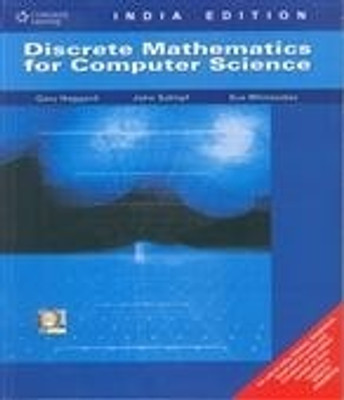Discrete Mathematics for Computer Science 1st Edition(English, Paperback, Haggard Gary)
Quick Overview
Product Price Comparison
An increasing number of computer scientists from diverse areas are using discrete mathematical structures to explain concepts and problems. Based on their teaching experiences, the authors offer an accessible text that emphasizes the fundamentals of discrete mathematics and its advanced topics. This text shows how to express precise ideas in clear mathematical language. Students discover the importance of discrete mathematics in describing computer science structures and problem solving. They also learn how mastering discrete mathematics will help them develop important reasoning skills that will continue to be useful throughout their careers. . Key Features Discusses applications such as relational database systems, the complexity of a computation, and normal forms of propositions. Builds on a strong, focused development of fundamental ideas about sets, logic, relations, and functions as well as graph theory and combinatorics. Presents algorithms in pseudocode to reinforce the applications of discrete structures. The book is flexible with most of the algorithm material being optional. Provides a wealth of exercises throughout each chapter to give students ample opportunity to master the material. Table Of Contents SETS, PROOF TEMPLATES, AND INDUCTION. Basic Definitions. Exercises. Operations on Sets. Exercises. The Principle of Inclusion-Exclusion. Exercises. Mathematical Induction. Program Correctness. Exercises. Strong Form of Mathematical Induction. Exercises. Chapter Review. FORMAL LOGIC. Introduction to Propositional Logic. Exercises. Truth and Logical Truth. Exercises. Normal Forms. Exercises. Predicates and Quantification. Exercises. Chapter Review. RELATIONS. Binary Relations. Operations on Binary Relations. Exercises. Special Types of Relations. Exercises. Equivalence Relations. Exercises. Ordering Relations. Exercises. Relational Databases: An Introduction. Exercises. Chapter Review. FUNCTIONS. Basic Definitions. Exercises. Operations on Functions. Sequences and Subsequences. Exercises. The Pigeon-Hole Principle. Exercises. Countable and Uncountable Sets. Exercises. Chapter Review. ANALYSIS OF ALGORITHMS. Comparing Growth Rates of Functions. Exercises. Complexity of Programs. Exercises. Uncomputability. Chapter Review. GRAPH THEORY. Introduction to Graph Theory. The Handshaking Problem. Paths and Cycles. Graph Isomorphism. Representation of Graphs. Exercises. Connected Graphs. The Konigsberg Bridge Problem. Exercises. Trees. Spanning Trees. Rooted Trees. Exercises. Directed Graphs. Applications: Scheduling a Meeting Facility. Finding a Cycle in a Directed Graph. Priority in Scheduling. Connectivity in Directed Graphs. Eulerian Circuits in Directed Graphs. Exercises. Chapter Review. COUNTING AND COMBINATORICS. Traveling Salesperson. Counting Principles. Set Decomposition Principle. Exercises. Permutations and Combinations. Constructing the kth Permutation. Exercises. Counting with Repeated Objects. Combinatorial Identities. Pascal's Triangle. Exercises. Chapter Review. DISCRETE PROBABILITY. Ideas of Chance in Computer Science. Exercises. Cross Product Sample Spaces. Exercises. Independent Events and Conditional Probability. Exercises. Discrete Random Variables. Exercises. Variance, Standard Deviation, and the Law of Averages. Exercises. Chapter Review. RECURRENCE RELATIONS. The Tower of Hanoi Problem. Solving First-Order Recurrence Relations. Exercises. Second-Order Recurrence Relations. Exercises. Divide-and-Conquer Paradigm. Binary Search. Merge Sort. Multiplication of n-Bit Numbers. Divide-and-Conquer Recurrence Relations. Exercises. Chapter Review.


